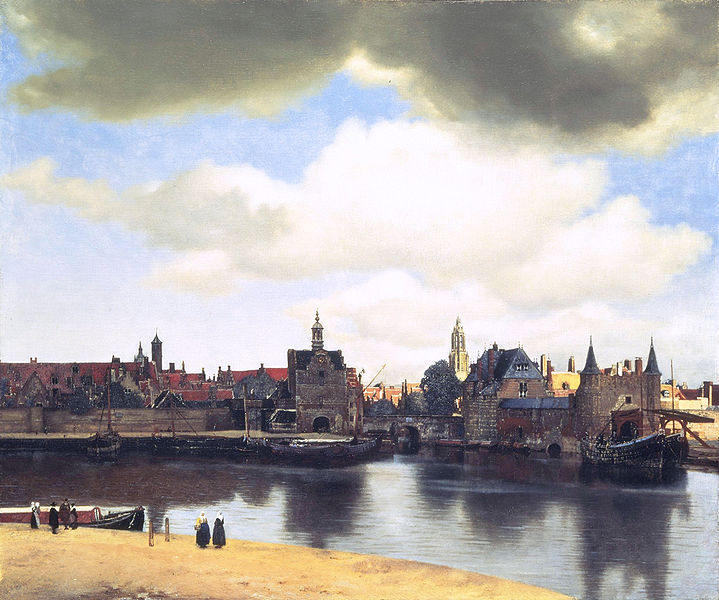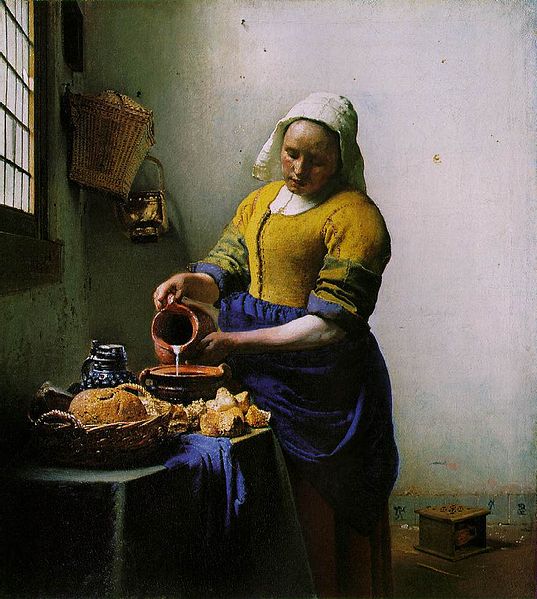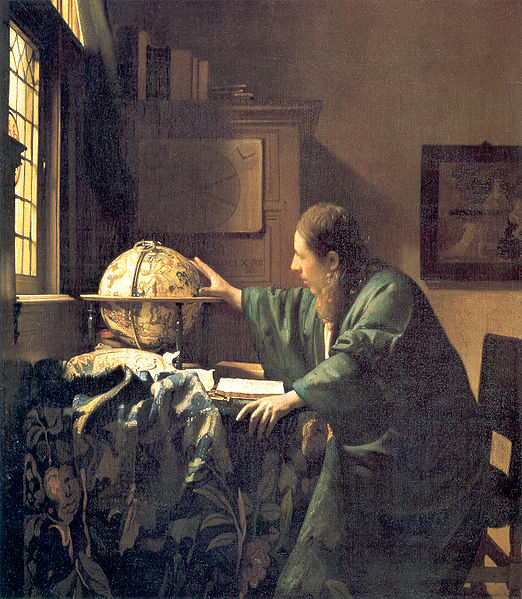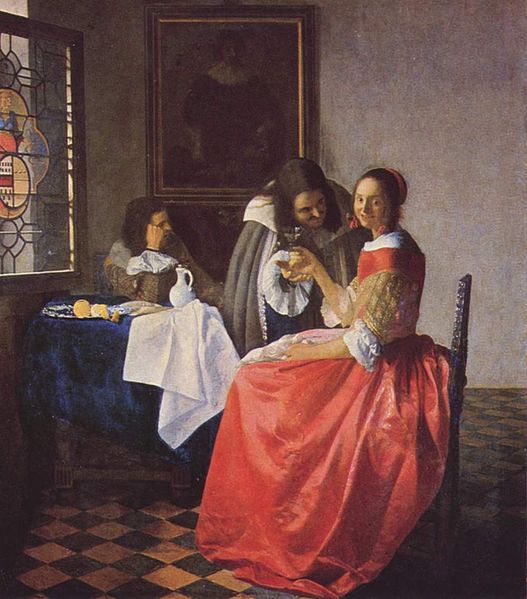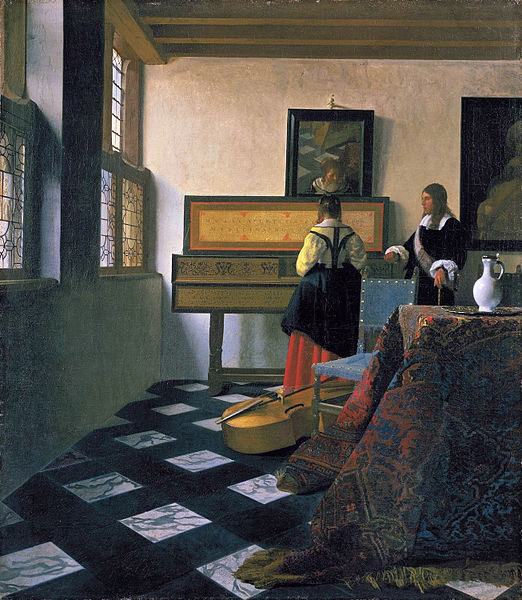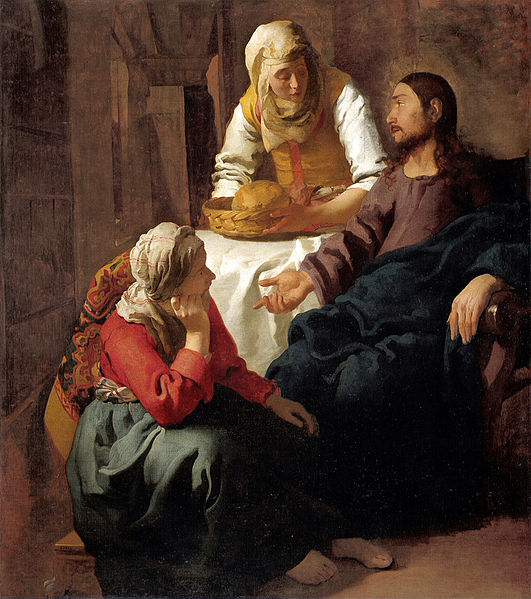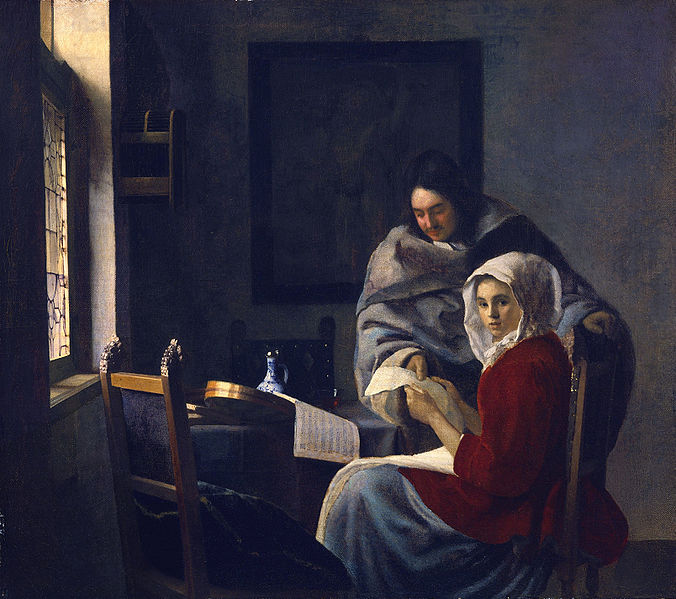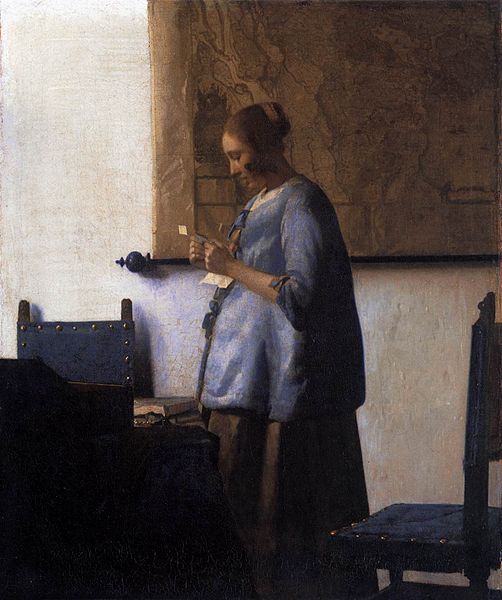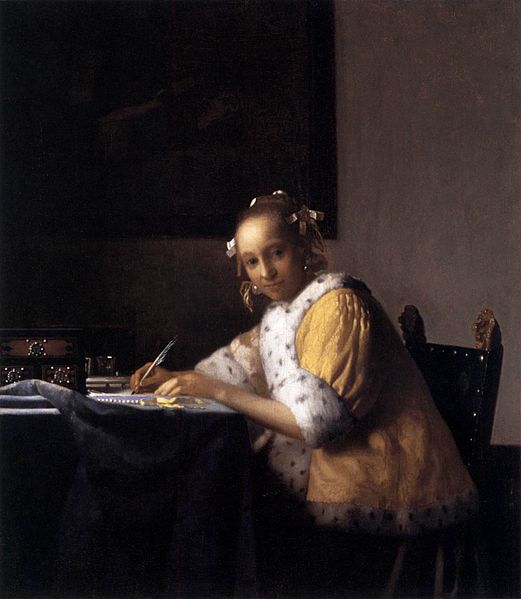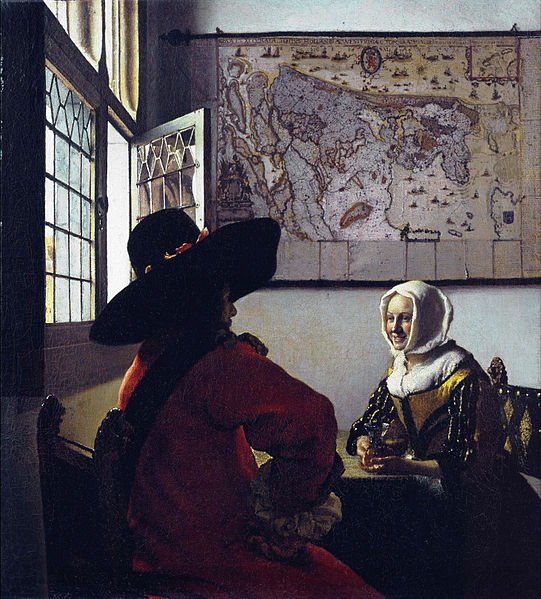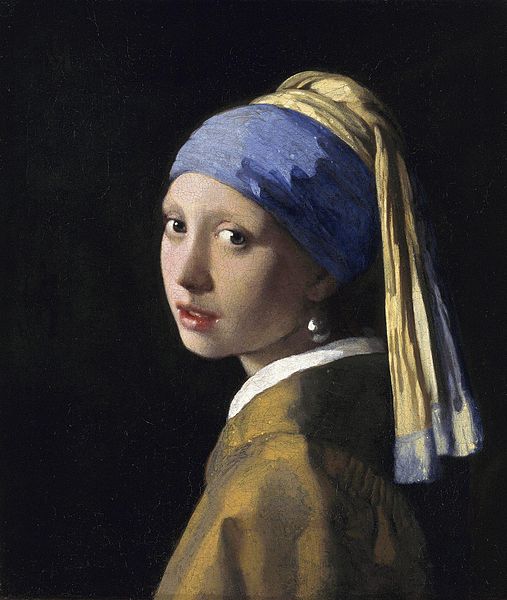<Back to Index>
- Painter Rembrandt Harmenszoon van Rijn, 1606
- Painter Johannes "Jan" Vermeer, 1632
PAGE SPONSOR
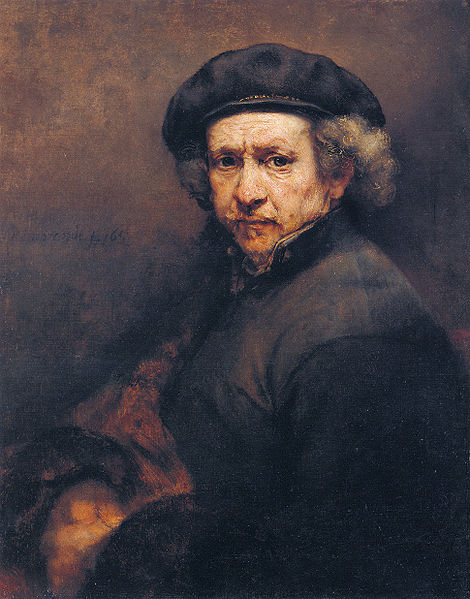
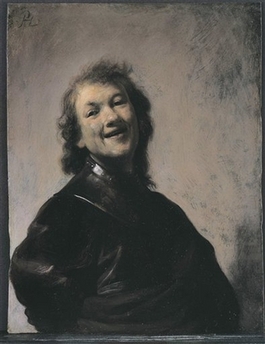
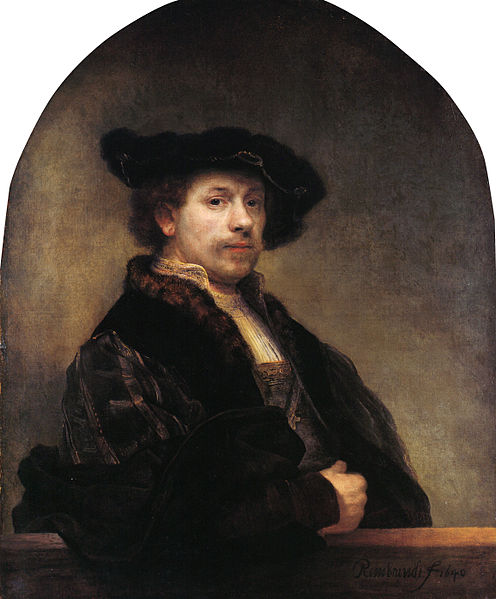
Rembrandt Harmenszoon van Rijn (15 July 1606 – 4 October 1669) was a Dutch painter and etcher. He is generally considered one of the greatest painters and printmakers in European art history and the most important in Dutch history. His contributions to art came in a period of great wealth and cultural achievement that historians call the Dutch Golden Age, when Dutch Golden Age painting, although in many ways antithetical to the Baroque style that dominated Europe, was extremely prolific and innovative.
Having achieved youthful success as a portrait painter, Rembrandt's later years were marked by personal tragedy and financial hardships. Yet his etchings and paintings were popular throughout his lifetime, his reputation as an artist remained high, and for twenty years he taught many important Dutch painters. Rembrandt's greatest creative triumphs are exemplified especially in his portraits of his contemporaries, self portraits and illustrations of scenes from the Bible. His self portraits form a unique and intimate biography, in which the artist surveyed himself without vanity and with the utmost sincerity.
In his paintings and prints he exhibited knowledge of classical iconography,
which he molded to fit the requirements of his own experience; thus,
the depiction of a biblical scene was informed by Rembrandt's knowledge
of the specific text, his assimilation of classical composition, and his
observations of Amsterdam's Jewish population. Because of his empathy for the human condition, he has been called "one of the great prophets of civilization."
Rembrandt Harmenszoon van Rijn was born on 15 July 1606 in Leiden, in the Dutch Republic, nowadays the Netherlands. He was the ninth child born to Harmen Gerritszoon van Rijn and Neeltgen Willemsdochter van Zuytbrouck. His family was quite well-to-do; his father was a miller and his mother was a baker's daughter. As a boy he attended Latin school and was enrolled at the University of Leiden, although according to a contemporary he had a greater inclination towards painting; he was soon apprenticed to a Leiden history painter, Jacob van Swanenburgh, with whom he spent three years. After a brief but important apprenticeship of six months with the famous painter Pieter Lastman in Amsterdam, Rembrandt opened a studio in Leiden in 1624 or 1625, which he shared with friend and colleague Jan Lievens. In 1627, Rembrandt began to accept students, among them Gerrit Dou.
In 1629 Rembrandt was discovered by the statesman Constantijn Huygens, the father of Christiaan Huygens (a famous Dutch mathematician and physicist), who procured for Rembrandt important commissions from the court of The Hague. As a result of this connection, Prince Frederik Hendrik continued to purchase paintings from Rembrandt until 1646.
At the end of 1631 Rembrandt moved to Amsterdam, then rapidly
expanding as the new business capital of the Netherlands, and began to
practice as a professional portraitist for the first time, with great
success. He initially stayed with an art dealer, Hendrick van Uylenburg, and in 1634, married Hendrick's cousin, Saskia van Uylenburg. Saskia came from a good family: her father had been lawyer and burgemeester
(mayor) of Leeuwarden. When Saskia, as the youngest daughter, became an
orphan, she lived with an older sister in Het Bildt. Rembrandt and
Saskia were married in the local church of St. Annaparochie without the presence of Rembrandt's relatives.
In the same year, Rembrandt became a burgess of Amsterdam and a member
of the local guild of painters. He also acquired a number of students,
among them Ferdinand Bol and Govert Flinck.
In 1635 Rembrandt and Saskia moved into their own house, renting in fashionable Nieuwe Doelenstraat. In 1639 they moved to a prominent house (now the Rembrandt House Museum) in the Jodenbreestraat in what was becoming the Jewish quarter; the mortgage to finance the 13,000 guilder purchase would be a primary cause for later financial difficulties. Rembrandt should easily have been able to pay the house off with his large income, but it appears his spending always kept pace with his income, and he may have made some unsuccessful investments. It was there that Rembrandt frequently sought his Jewish neighbors to model for his Old Testament scenes. Although they were by now affluent, the couple suffered several personal setbacks; their son Rumbartus died two months after his birth in 1635 and their daughter Cornelia died at just three weeks of age in 1638. In 1640, they had a second daughter, also named Cornelia, who died after living barely over a month. Only their fourth child, Titus, who was born in 1641, survived into adulthood. Saskia died in 1642 soon after Titus's birth, probably from tuberculosis. Rembrandt's drawings of her on her sick and death bed are among his most moving works.
During Saskia's illness, Geertje Dircx was hired as Titus' caretaker and nurse and also became Rembrandt's lover. She would later charge Rembrandt with breach of promise and was awarded alimony of 200 guilders a year. Rembrandt worked to have her committed for twelve years to an asylum or poorhouse (called a "bridewell") at Gouda, after learning she had pawned jewelry that had once belonged to Saskia and that he had given to her.
In the late 1640s Rembrandt began a relationship with the much
younger Hendrickje Stoffels, who had initially been his maid. In 1654
they had a daughter, Cornelia, bringing Hendrickje a summons from the
Reformed Church
to answer the charge "that she had committed the acts of a whore with
Rembrandt the painter". She admitted this and was banned from receiving
communion. Rembrandt was not summoned to appear for the Church council
because he was not a member of the Reformed Church.
The two were considered legally wed under common law, but Rembrandt had
not married Henrickje, so as not to lose access to a trust set up for
Titus in the son's mother's will.
Rembrandt lived beyond his means, buying art (including bidding up his own work), prints (often used in his paintings), and rarities, which probably caused a court arrangement to avoid his bankruptcy in 1656, by selling most of his paintings and large collection of antiquities. The sale list survives and gives us a good insight into Rembrandt's collections, which apart from Old Master paintings and drawings included busts of the Roman Emperors, suits of Japanese armor among many objects from Asia, and collections of natural history and minerals; the prices realized in the sales in 1657 and 1658 were disappointing. Rembrandt was forced to sell his house and his printing press and move to more modest accommodation on the Rozengracht in 1660. The authorities and his creditors were generally accommodating to him, except for the Amsterdam painters' guild, who introduced a new rule that no one in Rembrandt's circumstances could trade as a painter. To get round this, Hendrickje and Titus set up a business as art dealers in 1660, with Rembrandt as an employee.
In 1661 Rembrandt (or rather the new business) was contracted to complete work for the newly built city hall, but only after Govert Flinck, the artist previously commissioned, died without beginning to paint. The resulting work, The Conspiracy of Claudius Civilis, was rejected and returned to the painter; the surviving fragment is only a fraction of the whole work. It was around this time that Rembrandt took on his last apprentice, Aert de Gelder. In 1662 he was still fulfilling major commissions for portraits and other works. When Cosimo III de' Medici, Grand Duke of Tuscany, came to Amsterdam in 1667, he visited Rembrandt at his house.
Rembrandt outlived both Hendrickje, who died in 1663, and Titus, who
died in 1668, leaving a baby daughter. He died within a year of his son,
on October 4, 1669 in Amsterdam, and was buried in an unmarked grave in
the Westerkerk.
In a letter to Huyghens, Rembrandt offered the only surviving explanation of what he sought to achieve through his art: the greatest and most natural movement, translated from de meeste en de natuurlijkste beweegelijkheid. The word "beweechgelickhijt" is also argued to mean "emotion" or "motive." Whether this refers to objectives, material or otherwise is open to interpretation; either way, critics have drawn particular attention to the way Rembrandt seamlessly melded the earthly and spiritual.
Earlier 20th century connoisseurs claimed Rembrandt had produced over 600 paintings, nearly 400 etchings and 2,000 drawings. More recent scholarship, from the 1960s to the present day (led by the Rembrandt Research Project), often controversially, has winnowed his oeuvre to nearer 300 paintings. His prints, traditionally all called etchings, although many are produced in whole or part by engraving and sometimes drypoint, have a much more stable total of slightly under 300. It is likely Rembrandt made many more drawings in his lifetime than 2,000, but those extant are more rare than presumed. Two experts claim that the number of drawings whose autograph status can be regarded as effectively "certain" is no higher than about 75, although this is disputed.
At one time about ninety paintings were counted as Rembrandt self portraits, but it is now known that he had his students copy his own self portraits as part of their training. Modern scholarship has reduced the autograph count to over forty paintings, as well as a few drawings and thirty - one etchings, which include many of the most remarkable images of the group. Some show him posing in quasi - historical fancy dress, or pulling faces at himself. His oil paintings trace the progress from an uncertain young man, through the dapper and very successful portrait painter of the 1630s, to the troubled but massively powerful portraits of his old age. Together they give a remarkably clear picture of the man, his appearance and his psychological make up, as revealed by his richly weathered face.
In a number of biblical works, including The Raising of the Cross, Joseph Telling His Dreams and The Stoning of Saint Stephen, Rembrandt painted himself as a character in the crowd. Durham suggests that this was because the Bible was for Rembrandt "a kind of diary, an account of moments in his own life."
Among the more prominent characteristics of Rembrandt's work are his
use of chiaroscuro, the theatrical employment of light and shadow
derived from Caravaggio, or, more likely, from the Dutch Caravaggisti, but adapted for very personal means.
Also notable are his dramatic and lively presentation of subjects,
devoid of the rigid formality that his contemporaries often displayed,
and a deeply felt compassion for mankind, irrespective of wealth and
age. His immediate family — his wife Saskia, his son Titus and his
common law wife Hendrickje — often figured prominently in his paintings,
many of which had mythical, biblical or historical themes.
Throughout his career Rembrandt took as his primary subjects the themes of portraiture, landscape and narrative painting. For the last, he was especially praised by his contemporaries, who extolled him as a masterly interpreter of biblical stories for his skill in representing emotions and attention to detail. Stylistically, his paintings progressed from the early "smooth" manner, characterized by fine technique in the portrayal of illusionistic form, to the late "rough" treatment of richly variegated paint surfaces, which allowed for an illusionism of form suggested by the tactile quality of the paint itself.
A parallel development may be seen in Rembrandt's skill as a printmaker. In the etchings of his maturity, particularly from the late 1640s onward, the freedom and breadth of his drawings and paintings found expression in the print medium as well. The works encompass a wide range of subject matter and technique, sometimes leaving large areas of white paper to suggest space, at other times employing complex webs of line to produce rich dark tones.
It was during Rembrandt's Leiden period (1625 – 1631) that Lastman's
influence was most prominent. It is also likely that at this time
Lievens had a strong impact on his work as well. Paintings were rather
small, but rich in details (for example, in costumes and jewelry).
Religious and allegorical themes were favored, as were tronies.
In 1626 Rembrandt produced his first etchings, the wide dissemination
of which would largely account for his international fame. In 1629 he completed Judas Repentant, Returning the Pieces of Silver and The Artist in His Studio,
works that evidence his interest in the handling of light and variety
of paint application, and constitute the first major progress in his
development as a painter.
During his early years in Amsterdam (1632 – 1636), Rembrandt began to paint dramatic biblical and mythological scenes in high contrast and of large format (The Blinding of Samson, 1636, Belshazzar's Feast, c. 1635, Danaë, 1636), seeking to emulate the baroque style of Rubens. With the occasional help of assistants in Uylenburgh's workshop, he painted numerous portrait commissions both small (Jacob de Gheyn III) and large (Portrait of the Shipbuilder Jan Rijcksen and his Wife, 1633, Anatomy Lesson of Dr. Nicolaes Tulp, 1632).
By the late 1630s Rembrandt had produced a few paintings and many etchings of landscapes. Often these landscapes highlighted natural drama, featuring uprooted trees and ominous skies (Cottages before a Stormy Sky, c. 1641, The Three Trees, 1643). From 1640 his work became less exuberant and more sober in tone, possibly reflecting personal tragedy. Biblical scenes were now derived more often from the New Testament than the Old Testament, as had been the case before. In 1642 he painted The Night Watch, the most notable of the important group portrait commissions which he received in this period, and through which he sought to find solutions to compositional and narrative problems that had been attempted in previous works.
In the decade following the Night Watch, Rembrandt's paintings
varied greatly in size, subject, and style. The previous tendency to
create dramatic effects primarily by strong contrasts of light and
shadow gave way to the use of frontal lighting and larger and more
saturated areas of color. Simultaneously, figures came to be placed
parallel to the picture plane. These changes can be seen as a move
toward a classical mode of composition and, considering the more
expressive use of brushwork as well, may indicate a familiarity with
Venetian art (Susanna and the Elders, 1637 – 47). At the same time, there was a marked decrease in painted works in favor of etchings and drawings of landscapes. In these graphic works natural drama eventually made way for quiet Dutch rural scenes.
In the 1650s, Rembrandt's style changed again. Colors became richer and brush strokes more pronounced. With these changes, Rembrandt distanced himself from earlier work and current fashion, which increasingly inclined toward fine, detailed works. His singular approach to paint application may have been suggested in part by familiarity with the work of Titian, and could be seen in the context of the then current discussion of 'finish' and surface quality of paintings. Contemporary accounts sometimes remark disapprovingly of the coarseness of Rembrandt's brushwork, and the artist himself was said to have dissuaded visitors from looking too closely at his paintings. The tactile manipulation of paint may hearken to medieval procedures, when mimetic effects of rendering informed a painting's surface. The end result is a richly varied handling of paint, deeply layered and often apparently haphazard, which suggests form and space in both an illusory and highly individual manner.
In later years biblical themes were still depicted often, but emphasis shifted from dramatic group scenes to intimate portrait like figures (James the Apostle, 1661). In his last years, Rembrandt painted his most deeply reflective self portraits (from 1652 to 1669 he painted fifteen), and several moving images of both men and women (The Jewish Bride, c. 1666) — in love, in life, and before God.
Rembrandt produced etchings for most of his career, from 1626 to 1660,
when he was forced to sell his printing press and virtually abandoned
etching. Only the troubled year of 1649 produced no dated work. He took easily to etching and, though he also learned to use a burin and partly engraved
many plates, the freedom of etching technique was fundamental to his
work. He was very closely involved in the whole process of printmaking,
and must have printed at least early examples of his etchings himself.
At first he used a style based on drawing, but soon moved to one based
on painting, using a mass of lines and numerous bitings with the acid to
achieve different strengths of line. Towards the end of the 1630s, he
reacted against this manner and moved to a simpler style, with fewer
bitings. He worked on the so-called Hundred Guilder Print
in stages throughout the 1640s, and it was the "critical work in the
middle of his career", from which his final etching style began to
emerge. Although the print only survives in two states,
the first very rare, evidence of much reworking can be seen underneath
the final print and many drawings survive for elements of it.
In the mature works of the 1650s, Rembrandt was more ready to improvise on the plate and large prints typically survive in several states, up to eleven, often radically changed. He now uses hatching to create his dark areas, which often take up much of the plate. He also experimented with the effects of printing on different kinds of paper, including Japanese paper, which he used frequently, and on vellum. He began to use "surface tone," leaving a thin film of ink on parts of the plate instead of wiping it completely clean to print each impression. He made more use of drypoint, exploiting, especially in landscapes, the rich fuzzy burr that this technique gives to the first few impressions.
His prints have similar subjects to his paintings, although the
twenty - seven self portraits are relatively more common, and portraits of
other people less so. There are forty - six landscapes, mostly small,
which largely set the course for the graphic treatment of landscape
until the end of the 19th century. One third of his etchings are of
religious subjects, many treated with a homely simplicity, whilst others
are his most monumental prints. A few erotic, or just obscene,
compositions have no equivalent in his paintings.
He owned, until forced to sell it, a magnificent collection of prints
by other artists, and many borrowings and influences in his work can be
traced to artists as diverse as Mantegna, Raphael, Hercules Segers, and Giovanni Benedetto Castiglione.
Rembrandt painted The Militia Company of Captain Frans Banning Cocq between 1640 and 1642. This picture was called the Nachtwacht by the Dutch and the Night Watch by Sir Joshua Reynolds because by the 18th century the picture was so dimmed and defaced by time that it was almost indistinguishable and it looked quite like a night scene. After it was cleaned, it was discovered to represent broad day — a party of musketeers stepping from a gloomy courtyard into the blinding sunlight.
The piece was commissioned for the new hall of the Kloveniersdoelen, the musketeer branch of the civic militia. Rembrandt departed from convention, which ordered that such genre pieces should be stately and formal, rather a line-up than an action scene. Instead he showed the militia readying themselves to embark on a mission (what kind of mission, an ordinary patrol or some special event, is a matter of debate).
Contrary to what is often said, the work was hailed as a success from
the beginning. Parts of the canvas were cut off (approximately 20% from
the left hand side was removed) to make the painting fit its new
position when it was moved to Amsterdam town hall
in 1715; the Rijksmuseum has a smaller copy of what is thought to be
the full original composition; the four figures in the front are at the
center of the canvas. The painting is now in the Rijksmuseum, Amsterdam.
In 1968 the Rembrandt Research Project was started under the sponsorship of the Netherlands Organization for the Advancement of Scientific Research; it was initially expected to last a highly optimistic ten years. Art historians teamed up with experts from other fields to reassess the authenticity of works attributed to Rembrandt, using all methods available, including state - of - the - art technical diagnostics, and to compile a complete new catalogue raisonné of his paintings. As a result of their findings, many paintings that were previously attributed to Rembrandt have been removed from their list, although others have been added back. Many of those removed are now thought to be the work of his students.
One example of activity is The Polish Rider, in New York's Frick Collection. Its authenticity had been questioned years before by several scholars, led by Julius Held.
Many, including Dr. Josua Bruyn of the Foundation Rembrandt Research
Project, attributed the painting to one of Rembrandt's closest and most
talented pupils, Willem Drost,
about whom little is known. The Frick itself never changed its own
attribution, the label still reading "Rembrandt" and not "attributed to"
or "school of". More recent opinion has shifted in favor of the Frick,
with Simon Schama in his 1999 book Rembrandt's Eyes,
and a Rembrandt Project scholar, Ernst van de Wetering (Melbourne
Symposium, 1997) both arguing for attribution to the master. Many
scholars feel that the execution is uneven, and favor different
attributions for different parts of the work.
Another painting, Pilate Washing His Hands, is also of questionable attribution. Critical opinion of this picture has varied since 1905, when Wilhelm von Bode described it as "a somewhat abnormal work" by Rembrandt. Scholars have since dated the painting to the 1660s and assigned it to an anonymous pupil, possibly Arent de Gelder. The composition bears superficial resemblance to mature works by Rembrandt but lacks the master's command of illumination and modeling.
The attribution and re-attribution work is ongoing. In 2005 four oil paintings previously attributed to Rembrandt's students were reclassified as the work of Rembrandt himself: Study of an Old Man in Profile and Study of an Old Man with a Beard from a US private collection, Study of a Weeping Woman, owned by the Detroit Institute of Arts, and Portrait of an Elderly Woman in a White Bonnet, painted in 1640.
Rembrandt's own studio practice is a major factor in the difficulty of attribution, since, like many masters before him, he encouraged his students to copy his paintings, sometimes finishing or retouching them to be sold as originals, and sometimes selling them as authorized copies. Additionally, his style proved easy enough for his most talented students to emulate. Further complicating matters is the uneven quality of some of Rembrandt's own work, and his frequent stylistic evolutions and experiments. As well, there were later imitations of his work, and restorations which so seriously damaged the original works that they are no longer recognizable. It is highly likely that there will never be universal agreement as to what does and what does not constitute a genuine Rembrandt.
"Rembrandt" is a modification of the spelling of the artist's first name that he introduced in 1633. Roughly speaking, his earliest signatures (ca. 1625) consisted of an initial "R", or the monogram "RH" (for Rembrant Harmenszoon; i.e. "Rembrant, the son of Harmen"), and starting in 1629, "RHL" (the "L" stood, presumably, for Leiden). In 1632, he used this monogram early in the year, then added his patronymic to it, "RHL - van Rijn", but replaced this form in that same year and began using his first name alone with its original spelling, "Rembrant". In 1633 he added a "d", and maintained this form consistently from then on, proving that this minor change had a meaning for him (whatever it might have been). This change is purely visual; it does not change the way his name is pronounced. Curiously enough, despite the large number of paintings and etchings signed with this modified first name, most of their documents that mentioned him during his lifetime retained the original "Rembrant" spelling. (Note: the rough chronology of signature forms above applies to the paintings, and to a lesser degree to the etchings; from 1632, presumably, there is only one etching signed "RHL - v. Rijn," the large format "Raising of Lazarus," B 73). His practice of signing his work with his first name, later followed by Vincent van Gogh, was probably inspired by Raphael, Leonardo da Vinci and Michelangelo who, then as now, were referred to by their first names alone.
A letter published in 2004 by Margaret S. Livingstone, professor of neurobiology at Harvard Medical School, suggests that Rembrandt, whose eyes failed to align correctly, suffered from stereo blindness. This conclusion was made after studying 36 of Rembrandt's self portraits. Because he could not form a normal binocular vision, his brain automatically switched to one eye for many visual tasks. This disability could have helped him to flatten images he saw, and then put it onto the two dimensional canvas. Livingstone theorized that this was an advantage for the painter: "Art teachers often instruct students to close one eye in order to flatten what they see. Therefore, stereo blindness might not be a handicap — and might even be an asset — for some artists."
It is known that Rembrandt ran a large workshop and had many pupils. His fame was such that important dignitaries visiting Amsterdam wished to buy pieces, and he was more than willing to comply if he could. The list of Rembrandt pupils from his period in Leiden as well as his time in Amsterdam is quite long, mostly because his influence on painters around him was so great that it is difficult to tell whether someone worked for him in his studio or just copied his style for patrons eager to acquire a Rembrandt. A partial list should include Ferdinand Bol, Adriaen Brouwer, Gerrit Dou, Willem Drost, Heiman Dullaart, Gerbrand van den Eeckhout, Carel Fabritius, Govert Flinck, Hendrick Fromantiou, Arent de Gelder, Samuel Dirksz van Hoogstraten, Abraham Janssens, Godfrey Kneller, Philip de Koninck, Jacob Levecq, Nicolaes Maes, Jürgen Ovens, Christopher Paudiß, Willem de Poorter, Jan Victors, and Willem van der Vliet.
The most notable collections of Rembrandt's work are at Amsterdam's Rijksmuseum, including De Nachtwacht (The Night Watch) and Het Joodse bruidje (The Jewish Bride), The Hague's Mauritshuis, Hermitage Museum, St. Petersburg, the National Gallery, London, Gemäldegalerie, Berlin, Gemäldegalerie Alte Meister in Dresden, New York City, Washington, D.C., The Louvre, Nationalmuseum, Stockholm, and Kassel. His home, preserved as the Rembrandt House Museum in Amsterdam, displays many examples of his etchings; all major print rooms have the majority of these, although a number exist in only a handful of impressions (copies).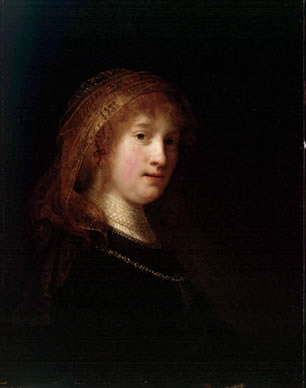
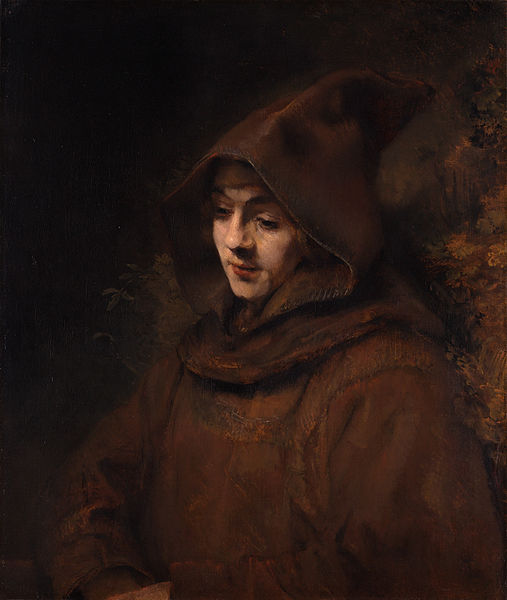
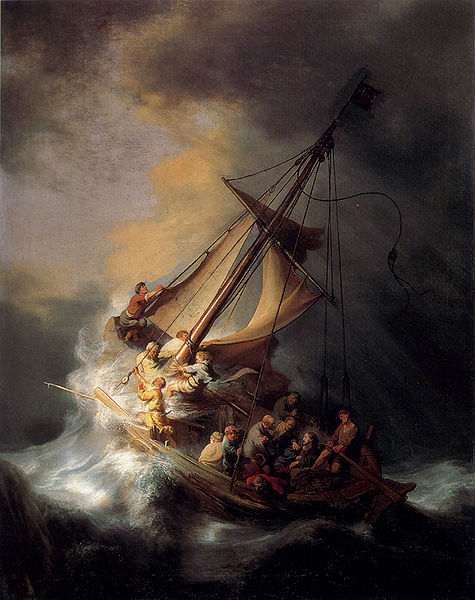
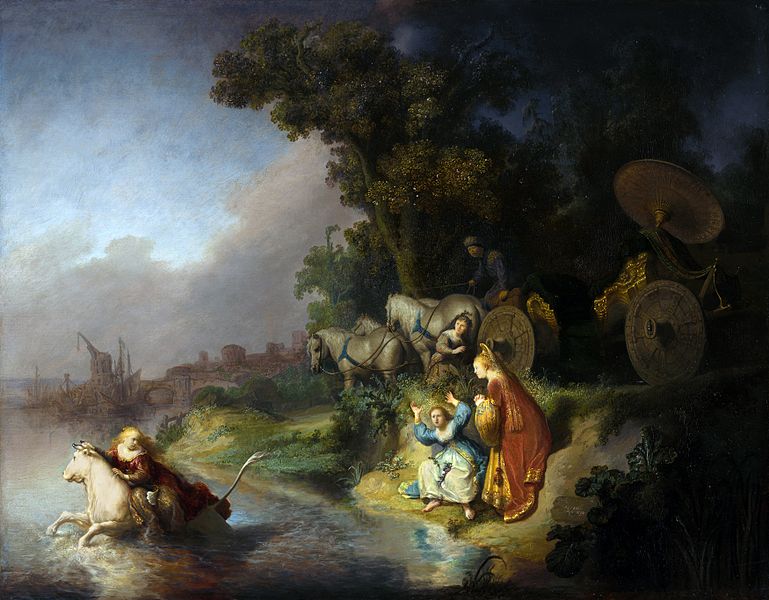
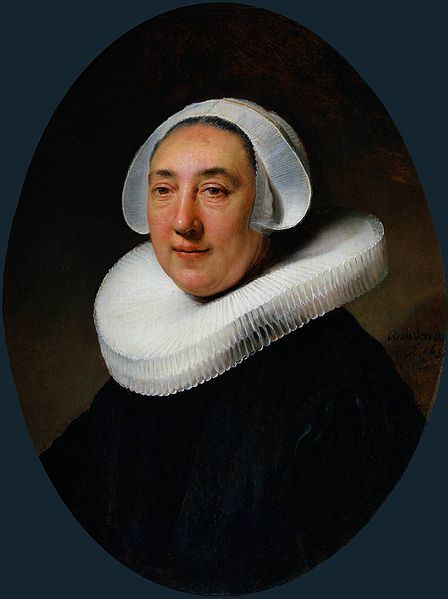
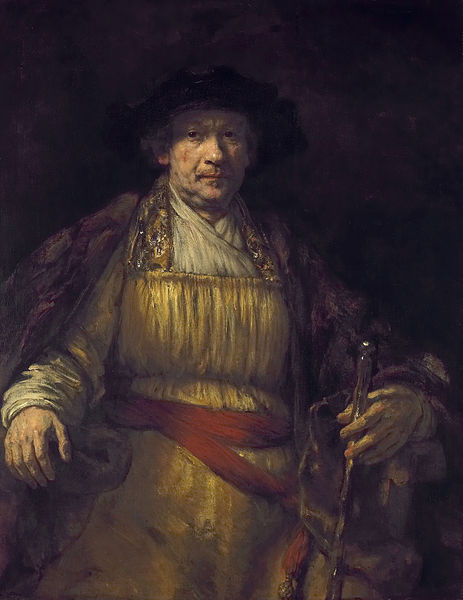
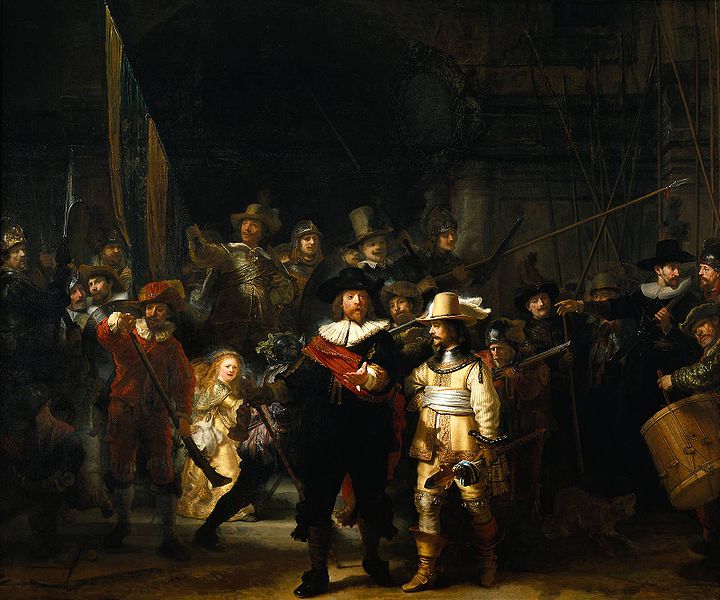
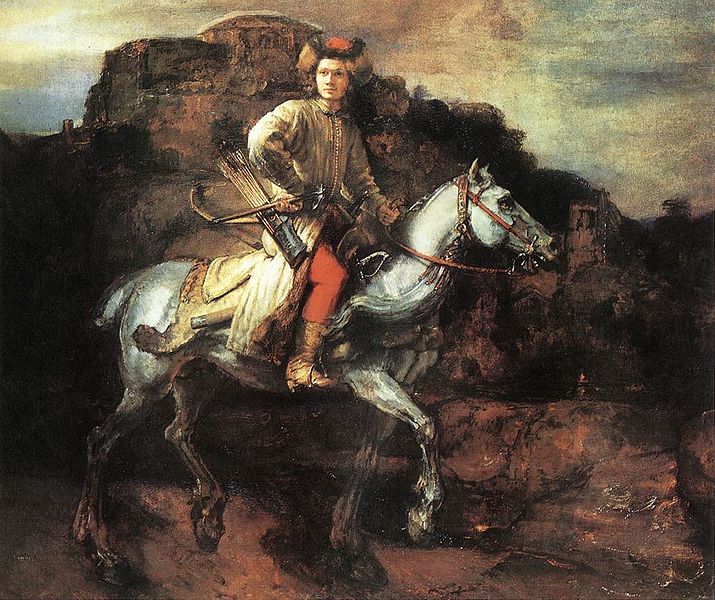
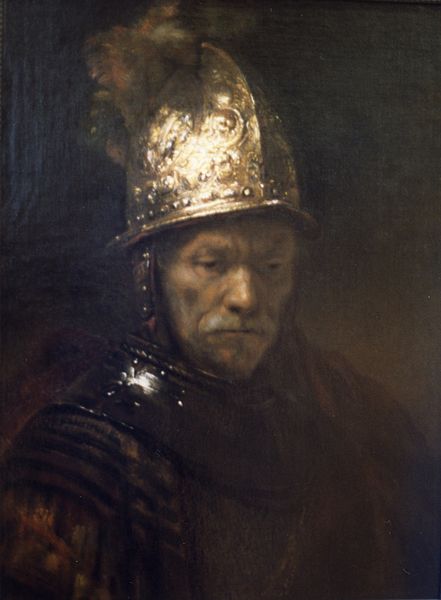
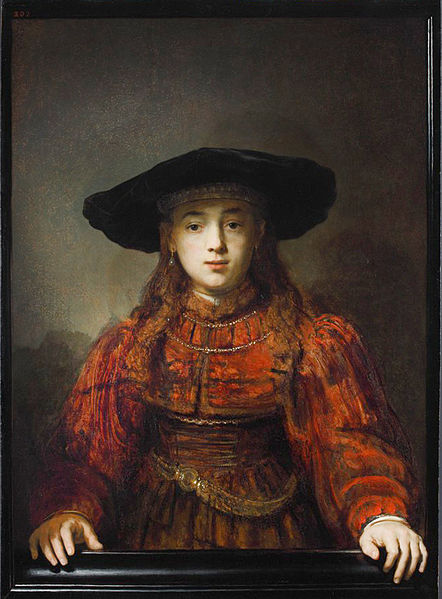
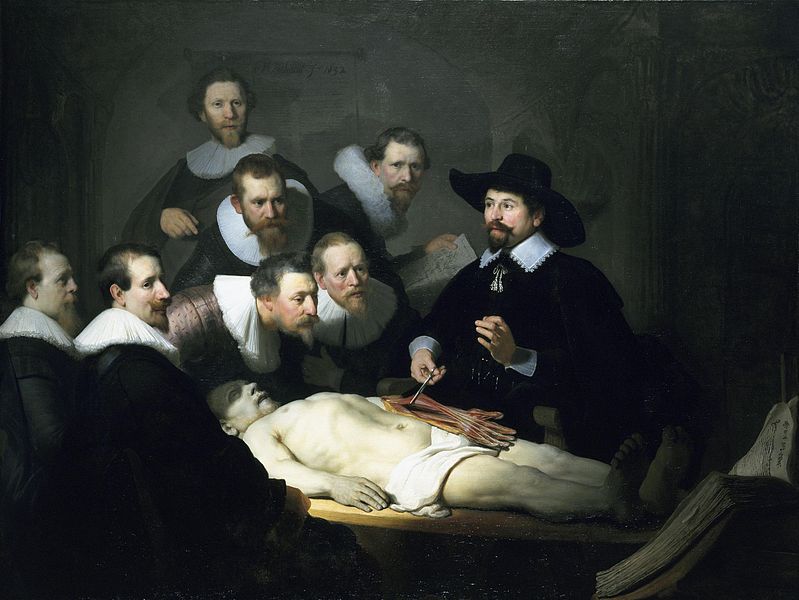
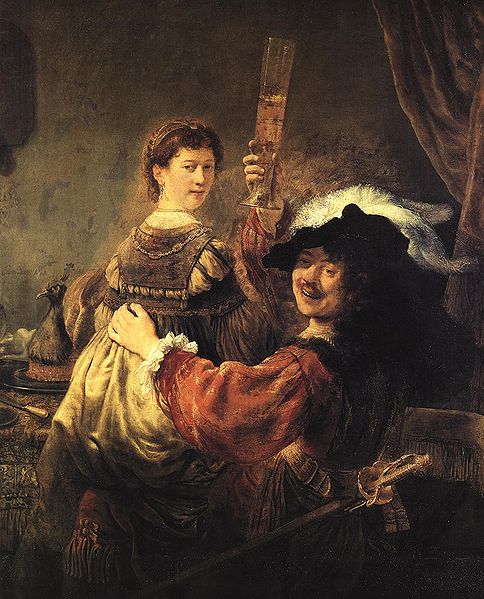
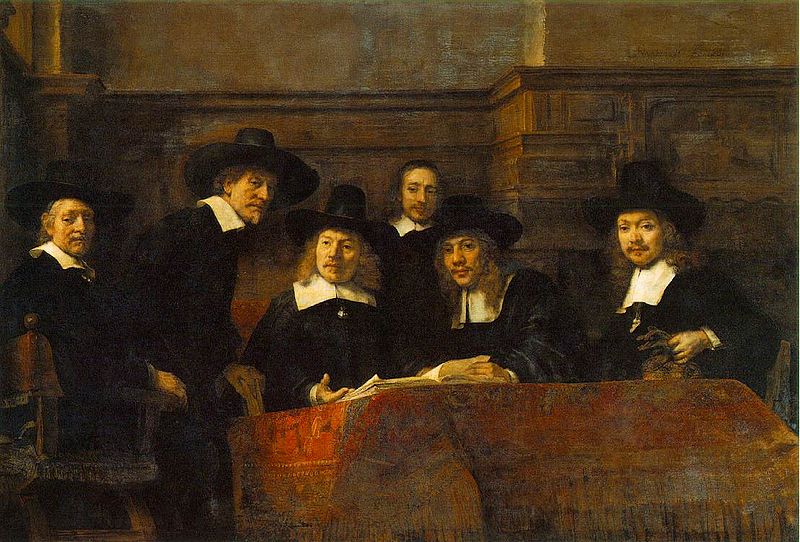
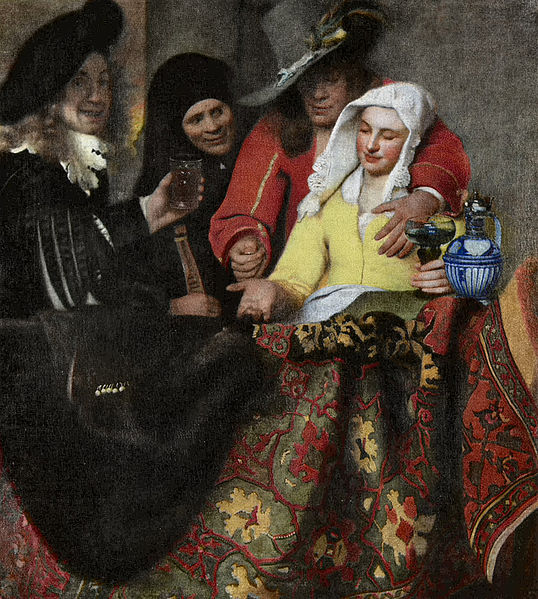
Johannes, Jan or Johan Vermeer (1632 – December 1675) was a Dutch painter who specialized in exquisite, domestic interior scenes of middle class life. Vermeer was a moderately successful provincial genre painter in his lifetime. He seems never to have been particularly wealthy, leaving his wife and children in debt at his death, perhaps because he produced relatively few paintings.
Vermeer worked slowly and with great care, using bright colors and sometimes expensive pigments, with a preference for cornflower blue and yellow. He is particularly renowned for his masterly treatment and use of light in his work.
Vermeer painted mostly domestic interior scenes. As Koning points out: "Almost all his paintings are apparently set in two smallish rooms in his house in Delft; they show the same furniture and decorations in various arrangements and they often portray the same people, mostly women".
Recognized during his lifetime in Delft and The Hague, his modest celebrity gave way to obscurity after his death; he was barely mentioned in Arnold Houbraken's major source book on 17th century Dutch painting (Grand Theatre of Dutch Painters and Women Artists), and was thus omitted from subsequent surveys of Dutch art for nearly two centuries. In the 19th century Vermeer was rediscovered by Gustav Friedrich Waagen and Théophile Thoré - Bürger, who published an essay attributing sixty - six pictures to him, although only thirty - four paintings are universally attributed to him today. Since that time Vermeer's reputation has grown, and he is now acknowledged as one of the greatest painters of the Dutch Golden Age.
Relatively little is known about Vermeer's life. He was baptized in Delft on 31 October 1632 as Joannis, and buried in the same city under the name Jan on 15 December 1675. He seems to have been exclusively devoted to his art, living out his life in the city of Delft. The only sources of information are some registers, a few official documents and comments by other artists; it was for this reason that Thoré Bürger named him "The Sphinx of Delft".
On 31 October 1632, Johannes was baptized in the Reformed Church. His father, Reijnier Janszoon, was a middle class worker of silk or caffa (a mixture of silk and cotton or wool). As an apprentice in Amsterdam, Reijnier lived on fashionable Sint Antoniesbreestraat, then a street with many resident painters. In 1615 he married Digna Baltus. The couple moved to Delft and had a daughter, Gertruy, who was baptized in 1620. In 1625 Reijnier was involved in a fight with a soldier named Willem van Bylandt, who died from his wounds five months later. Around this time Reijnier began dealing in paintings. In 1631 he leased an inn called "The Flying Fox". In 1641 he bought a larger inn on the market square, named after the Flemish town "Mechelen". The acquisition of the inn constituted a considerable financial burden. When Vermeer's father died in October 1652, Vermeer assumed operation of the family's art business.
In April 1653 Johannes Reijniersz Vermeer married a Catholic
girl, Catharina Bolenes (Bolnes). The blessing took place in a nearby
and quiet village Schipluiden. For the groom it was a good match. His
mother - in - law, Maria Thins, was significantly wealthier than he, and
it was probably she who insisted Vermeer convert to Catholicism before
the marriage on 5 April. Some scholars doubt that Vermeer became Catholic, but one of his paintings, Allegory of Catholic Faith,
made between 1670 and 1672, placed less emphasis on the artists’ usual
naturalistic concerns, and more on religious symbolic applications,
including the sacrament of the Eucharist, which was scorned by the
Protestant order at the time. Walter Liedtke in Dutch Paintings in the Metropolitan Museum of Art suggests it was made for a learned and devout Catholic patron, perhaps for his schuilkerk, or "hidden church."
So, whether it represents Vermeer’s own beliefs or only those of his
patron is left to speculation. At some point the couple moved in with
Catharina's mother, who lived in a rather spacious house at Oude Langendijk, almost next to a hidden Jesuit church.
Here Vermeer lived for the rest of his life, producing paintings in the
front room on the second floor. His wife gave birth to 14 children,
four of whom were buried before being baptized, but were registered as
"child of Johan Vermeer".
From wills written by relatives, the names of ten of Vermeer's children
are known: Maria, Elisabeth, Cornelia, Aleydis, Beatrix, Johannes,
Gertruyd, Franciscus, Catharina, and Ignatius.
Several of these names carry a religious connotation, and it is likely
that the youngest, Ignatius, was named after the founder of the Jesuit
order.
It is unclear where and with whom Vermeer apprenticed as a painter. Speculation that Carel Fabritius may have been his teacher is based upon a controversial interpretation of a text written in 1668 by the printer Arnold Bon. Art historians have found no hard evidence to support this. The local authority, Leonaert Bramer, acted as a friend but their style of painting is rather different. Liedtke suggests Vermeer taught himself, using information from one of his father's connections. Some scholars think Vermeer was trained under the Catholic painter Abraham Bloemaert. Vermeer's style is similar to that of some of the Utrecht Carravagists, whose works are depicted as paintings - within - paintings in the backgrounds of several of his compositions. In Delft, Vermeer probably competed with Pieter de Hooch and Nicolaes Maes, who produced genre works in a similar style.
On 29 December 1653, Vermeer became a member of the Guild of Saint Luke, a trade association for painters. The guild's records make clear that Vermeer did not pay the usual admission fee. It was a year of plague, war and economic crisis; Vermeer was not alone in experiencing difficult financial circumstances. In 1654 the city suffered the terrible explosion known as the Delft Thunderclap, which destroyed a large section of the city. In 1657 he might have found a patron in the local art collector Pieter van Ruijven, who lent him some money. In 1662 Vermeer was elected head of the guild and was reelected in 1663, 1670, and 1671, evidence that he (like Bramer) was considered an established craftsman among his peers. Vermeer worked slowly, probably producing three paintings a year, and on order. When Balthasar de Monconys visited him in 1663 to see some of his work, the diplomat and the two French clergymen who accompanied him were sent to Hendrick van Buyten, a baker, who had a couple of his paintings as collateral.
In 1671 Gerrit van Uylenburgh organized the auction of Gerrit Reynst's collection and offered thirteen paintings and some sculptures to Frederick William, Elector of Brandenburg. Frederick accused them of being counterfeits and had sent twelve back on the advice of Hendrick Fromantiou. Van Uylenburg then organized a counter - assessment, asking a total of 35 painters to pronounce on their authenticity, including Jan Lievens, Melchior de Hondecoeter, Gerbrand van den Eeckhout and Johannes Vermeer.
In 1672 a severe economic downturn (the "Year of Disaster") struck the Netherlands, after Louis XIV and a French army invaded the Dutch Republic from the south (known as the Franco - Dutch War). During the Third Anglo - Dutch War an English fleet and two allied German bishops attacked the country from the east causing more destruction. Many people panicked; courts, theaters, shops and schools were closed. Five years passed before circumstances improved. In the summer of 1675 Vermeer borrowed money in Amsterdam, using his mother - in - law as a surety.
In December 1675 Vermeer fell into a frenzy and, within a day and a half, died. He was buried in the Protestant Old Church on 15 December 1675. Catharina Bolnes attributed her husband's death to the stress of financial pressures. The collapse of the art market damaged Vermeer's business as both a painter and an art dealer. She, having to raise 11 children, asked the High Court to relieve her of debts owed to Vermeer's creditors. The Dutch microscopist Antonie van Leeuwenhoek, who worked for the city council as a surveyor, was appointed trustee. The house, with eight rooms on the first floor, was filled with paintings, drawings, clothes, chairs, and beds. In his atelier there were two chairs, two painter's easels, three palettes, ten canvases, a desk, an oak pull table, a small wooden cupboard with drawers and "rummage not worthy being itemized". Nineteen of Vermeer's paintings were bequeathed to Catharina and her mother. The widow sold two more paintings to Hendrick van Buyten in order to pay off a substantial debt for delivered bread.
Vermeer had been a respected artist in Delft, but almost unknown
outside his home town. The fact that a local patron, Pieter van Ruijven,
purchased much of his output reduced the possibility of his fame
spreading. Several factors contributed to his limited oeuvre.
Vermeer never had any pupils and therefore there was no school of
Vermeer. His family obligations with so many children may have taken up
much of his time as would acting as both an art dealer and inn keeper in
running the family businesses. His time spent serving as head of the
guild and his extraordinary precision as a painter may have also limited his output.
Like most painters of his time, Vermeer probably first executed his paintings tonally, using either only shades of gray ("grisaille"), or a limited palette of browns and grays ("dead coloring"), over which more saturated colors (reds, yellows and blues) were applied in the form of glazes. Vermeer produced transparent colors by applying paint to the canvas in loosely granular layers, a technique called pointillé (not to be confused with pointillism). No drawings have been positively attributed to Vermeer, and his paintings offer few clues to preparatory methods. David Hockney, among other historians and advocates of the Hockney – Falco thesis, has speculated that Vermeer used a camera obscura to achieve precise positioning in his compositions, and this view seems to be supported by certain light and perspective effects. The often discussed sparkling pearly highlights in Vermeer's paintings have been linked to this possible use of a camera obscura, the primitive lens of which would produce halation. Exaggerated perspective can be seen in Lady at the Virginals with a Gentleman (London, Royal Collection). Vermeer's interest in optics is also attested in this work by the accurately observed mirror reflection above the lady at the virginals.
However, the extent of Vermeer's dependence upon the camera obscura is disputed by historians. There is no historical evidence. The detailed inventory of the artist's belongings drawn up after his death does not include a camera obscura or any similar device. Scientific evidence is limited to inference. Philip Steadman has found six Vermeer paintings that are precisely the right size if they were inside a camera obscura where the back wall of his studio was where the images were projected.
There is no other seventeenth century artist who early in his career employed, in the most lavish way, the exorbitantly expensive pigment lapis lazuli, or natural ultramarine. Vermeer not only used this in elements that are naturally of this color; the earth colors umber and ochre should be understood as warm light within a painting's strongly lit interior, which reflects its multiple colors onto the wall. In this way, he created a world more perfect than any he had witnessed. This working method most probably was inspired by Vermeer’s understanding of Leonardo’s observations that the surface of every object partakes of the color of the adjacent object. This means that no object is ever seen entirely in its natural color.
A comparable but even more remarkable, yet effectual, use of natural ultramarine is in The Girl with a Wineglass. The shadows of the red satin dress are underpainted in natural ultramarine, and, owing to this underlying blue paint layer, the red lake and vermilion mixture applied over it acquires a slightly purple, cool and crisp appearance that is most powerful.
Even after Vermeer’s supposed financial breakdown following the so-called rampjaar (year of disaster) in 1672, he continued to employ natural ultramarine generously, such as in Lady Seated at a Virginal. This could suggest that Vermeer was supplied with materials by a collector, and would coincide with John Michael Montias’ theory of Pieter van Ruijven being Vermeer’s patron.
His works are largely genre pieces and portraits, with the exception of two cityscapes and two allegories.
His subjects offer a cross section of seventeenth century Dutch
society, ranging from the portrayal of a simple milkmaid at work, to the
luxury and splendor of rich notables and merchantmen in their roomy
houses. Besides these subjects, religious, poetical, musical, and
scientific comments can also be found in his work.
Only three paintings are dated: The Procuress (1656, Dresden, Gemäldegalerie), The Astronomer (1668, Paris, Louvre), and The Geographer (1669, Frankfurt, Städelsches Kunstinstitut).
Vermeer's mother - in - law, Maria Thins, owned Dirck van Baburen's 1622 oil - on - canvas Procuress (or a copy of it), which appears in the background of two of Vermeer's paintings. The same subject was also painted by Vermeer. After creating his own The Procuress, almost all of Vermeer's paintings are of contemporary subjects in a smaller format, with a cooler palette dominated by blues, yellows and grays. Practically all of his surviving works belong to this period; usually domestic interiors with one or two figures lit by a window on the left. They are characterized by a serene sense of compositional balance and spatial order, unified by a pearly light. Mundane domestic or recreational activities become thereby imbued with a poetic timelessness (e.g., Girl Reading a Letter at an Open Window, Dresden, Gemäldegalerie). Vermeer's two townscapes, View of Delft (The Hague, Mauritshuis) and A street in Delft (Amsterdam, Rijksmuseum), have also been attributed to this period.
A few of his paintings show a certain hardening of manner and are
generally thought to represent his late works. From this period come The Allegory of Faith (c 1670, New York, Metropolitan Museum) and The Love Letter (c 1670, Amsterdam, Rijksmuseum).
- Upon the rediscovery of Vermeer's work in the 19th century, several prominent Dutch artists, including Simon Duiker, modeled their style on his work.
- Vermeer's View of Delft features in a pivotal sequence of Marcel Proust's The Captive.
- Salvador Dalí, with great admiration for Vermeer, painted his own version of The Lacemaker and pitted large copies of the original against a rhinoceros in some now - famous surrealist experiments. Dali also immortalized the Dutch Master in The Ghost of Vermeer of Delft Which Can Be Used As a Table, 1934.
- Han van Meegeren was a 20th century Dutch painter who worked in the classical tradition. Motivated by a blend of aesthetic and financial reasons, van Meegeren became a master forger, creating and selling many new 'Vermeers' before being caught and tried.
- Peter Greenaway's film A Zed & Two Noughts (1985) contains a plot line about an orthopedic surgeon named Van Meegeren who stages highly exact scenes from Vermeer paintings in order to paint copies of them.
- Dutch composer Louis Andriessen based his opera, Writing to Vermeer (1997 – 98, libretto by Peter Greenaway), on the domestic life of Vermeer.
- Tracy Chevalier's novel Girl with a Pearl Earring and the film of the same name (2003) are named after the painting; they present a fictional account of its creation by Vermeer and his relationship with the model. The film was nominated for Oscars in cinematography, art direction and costume design.
- Susan Vreeland's novel Girl in Hyacinthe Blue follows eight individuals with a relationship to a painting of Vermeer. The novel follows a reverse chronology from the current period to the time of Vermeer.
- The young adult novel Chasing Vermeer by Blue Balliett centers around the fictitious theft of Vermeer's A Lady Writing.
- Historian Timothy Brook's Vermeer's Hat: The Seventeenth Century and the Dawn of the Global World (2007) examines six of Vermeer's paintings for evidence of world trade and globalization during the Dutch Golden Age.
- A 2010 Epsom Derby Favorite was named Jan Vermeer.
- Two Vermeer paintings, Girl with a Pearl Earring and The Milkmaid, are obtainable in the Animal Crossing video game series as the "Wistful Painting" and the "Quaint Painting", respectively.
- The song "No one was like Vermeer" by Bostonian singer - songwriter Jonathan Richman pays tribute to Vermeer's painstaking technique.
- Bob Walkenhorst in his solo album "The Beginner" wrote a rockabilly song, "Jan Vermeer", which begins with "I wish I could dance like Jan Vermeer!"
- J.P. Smith's novel, The Discovery of Light, deals largely with Vermeer.
- In the Bret Easton Ellis novel The Rules of Attraction, the character of Victor is traveling throughout Europe and notes, upon visiting the Vatican museums, that "the Vermeers were intense."
